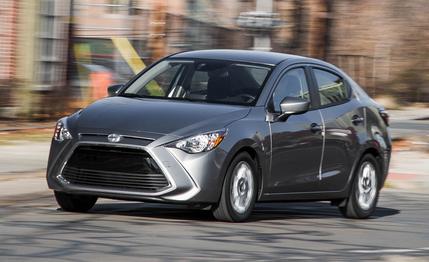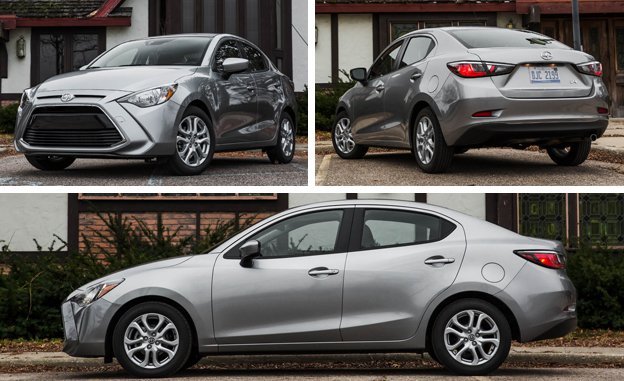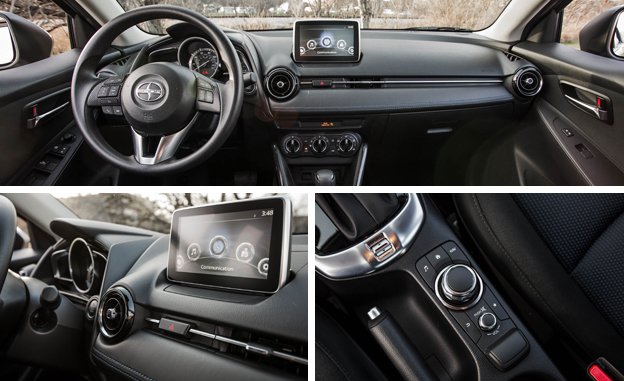
 Instrumented Test
Instrumented Test
At the time of this publishing, the Scion division is in the process of being dismantled and having the bulk of its lineup transferred under the Toyota banner. Although we can’t say we’re surprised at the announcement, the timing is unfortunate. For the first time in years, Scion has, in the recently minted iA subcompact, a model that hits the brand’s ostensible targets: a low price of entry and fun dynamics, as well as big bang for the buck in terms of interior goodness and build quality. As for exterior styling, well, looks are subjective.
Arguably the most interesting thing about the iA is that, unlike most every other Scion to date, it wasn’t sourced from the vast international product reserves of its parent company Toyota. Instead, it comes from Mazda. Although it’s known that the two manufacturers were shacking up to share some platforms and manufacturing capabilities, the iA is a 2016 Mazda 2 sedan straight up, a model that doesn’t come to the United States. Still, Scion thought it best to differentiate its version, adding an incredibly unfortunate front fascia and revised headlamp hardware. But once you get past its gaping maw, which has drawn criticism for its resemblance to a bottom-feeding, gill-breathing Cyprinidae, the outsourced iA proves to be an impressive value.


We’re on the record about how we dig that the iA has features such as a tilting and telescoping steering wheel, as well as its 7.0-inch infotainment system that includes an intuitive control dial, Bluetooth with voice recognition, two USB inputs, an auxiliary input, and iPod connectivity. Add features such as 16-inch wheels, a backup camera, cruise control, air conditioning, and a six-speed automatic transmission (we’ve previously tested the 2016 iA with a manual transmission) and you have a heaping helping of content for the very reasonable ask of $17,570. Attempts to option an iA to price points northward are almost futile, as only three modestly priced dealer-installed options were available at the time of this test: wheel locks ($65), a textured appliqué for the rear bumper ($77), and a navigation-enabling SD card ($419). Getting that new-car smell for less than $20K often means sacrificing desired equipment, but the iA’s ample list of goodies means you’re not punished for being thrifty.
Power for the iA comes from Mazda’s 1.5-liter inline-four, a smooth operator that loves to spinrev, which is good, as its full complement of 106 horsepower doesn’t arrive until 6000 rpm. All 103 lb-ft of torque comes onstream at 4000 rpm, and while this naturally aspirated engine lacks the urgency displayed by the new crop of small-displacement turbocharged engines, its linear power delivery offers predictable performance. The six-speed automatic does a dandy job of flying under the radar, unobtrusively swapping cogs with no unsavory behavior. Selecting Sport mode on the console triggers the transmission’s wilder side, and the more-aggressive shift map holds gears longer and shifts between ratios more quickly. Fully caned, the powertrain propelled our iA test car from zero to 60 mph in 9.1 seconds and across a quarter-mile in 17.1 seconds at 82 mph. Those numbers each trail those of the manually shifted iA by just one-tenth of a second.


But numbers are only part of the story; the iA is one of those small cars that just encourages you to drive it hard. The damping is first-rate, expertly toeing the elusive line between controlled handling and decent ride quality. Unwinding a twisty section of road approaches genuine fun, and—this is particularly cool—the transmission’s Sport mode even perfectly nails downshifts under braking in anticipation of an upcoming corner. Speaking of braking, that’s one place where pinched pennies are evident, as the iA still runs drums in the rear. The pedal feels firm and reassuring, but the iA took 185 feet to stop from 70 mph, 10 to 20 feet longer than the best in the segment. Most of the blame can be assigned to the 185/60R-16 Toyo Proxes A27 tires, which give up grip easily and unpredictably.
While the acceleration and braking numbers may be average, the iA’s fuel-economy figures are anything but. We achieved 36 mpg overall, just one mpg fewer than the official EPA combined rating of 37, and three better than its 33-mpg city rating. Considering our driving style, this is a big plus for the Scion.
Conceived to put fun, affordable vehicles in the hands of younger buyers, Scion ultimately had to go to Mazda in order to fulfill that mission—so it’s no wonder the brand failed. Thankfully, the iA is scheduled to live on as a Toyota. Maybe they’ll even fix its nose.